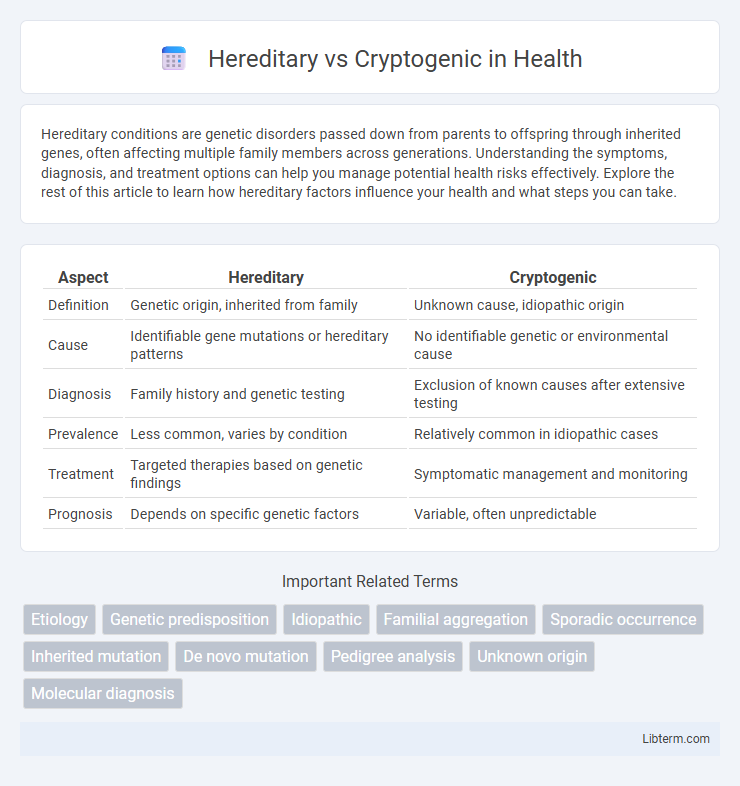Hereditary conditions are genetic disorders passed down from parents to offspring through inherited genes, often affecting multiple family members across generations. Understanding the symptoms, diagnosis, and treatment options can help you manage potential health risks effectively. Explore the rest of this article to learn how hereditary factors influence your health and what steps you can take.
Table of Comparison
| Aspect | Hereditary | Cryptogenic |
|---|---|---|
| Definition | Genetic origin, inherited from family | Unknown cause, idiopathic origin |
| Cause | Identifiable gene mutations or hereditary patterns | No identifiable genetic or environmental cause |
| Diagnosis | Family history and genetic testing | Exclusion of known causes after extensive testing |
| Prevalence | Less common, varies by condition | Relatively common in idiopathic cases |
| Treatment | Targeted therapies based on genetic findings | Symptomatic management and monitoring |
| Prognosis | Depends on specific genetic factors | Variable, often unpredictable |
Understanding Hereditary Origins
Hereditary disorders arise from genetic mutations inherited from one or both parents, often identified through family medical history and genetic testing. Cryptogenic conditions lack a clear or known cause despite extensive clinical evaluation, making their origins more challenging to trace. Understanding hereditary origins enables targeted genetic counseling and early intervention strategies to manage inherited diseases effectively.
Defining Cryptogenic Conditions
Cryptogenic conditions refer to diseases or disorders with an unknown or unclear cause despite thorough medical evaluation, distinguishing them from hereditary conditions which have a well-defined genetic basis. These cryptogenic cases often challenge clinicians as they lack identifiable genetic markers or familial patterns commonly seen in hereditary diseases. Advances in genomic research and diagnostic tools continue to help investigate cryptogenic conditions, aiming to uncover underlying causes that remain elusive in many patients.
Genetic Markers in Hereditary Disorders
Hereditary disorders are often identified by specific genetic markers such as BRCA1 and BRCA2 for breast cancer or HTT gene mutations in Huntington's disease, enabling precise diagnosis and risk assessment. Cryptogenic disorders, in contrast, lack clearly defined genetic markers, making their origins and inheritance patterns ambiguous despite similar clinical presentations. Advances in genomic sequencing continue to refine the identification of genetic mutations responsible for hereditary conditions, differentiating them from cryptogenic cases with unknown etiology.
Diagnostic Challenges of Cryptogenic Cases
Cryptogenic cases pose significant diagnostic challenges due to their unknown etiology despite comprehensive testing, often requiring advanced genetic, imaging, and biomarker analysis to exclude hereditary causes. The absence of identifiable genetic mutations or family history in cryptogenic conditions complicates differentiation from hereditary disorders, necessitating multifaceted clinical and molecular evaluations. Accurate diagnosis impacts treatment strategies, making early and precise identification critical for managing cryptogenic cases effectively.
Common Diseases: Hereditary vs. Cryptogenic
Hereditary diseases, such as cystic fibrosis and Huntington's disease, result from genetic mutations passed down through families, while cryptogenic diseases like cryptogenic cirrhosis often lack a clear cause despite thorough investigation. Common hereditary diseases display identifiable genetic markers, enabling diagnostic genetic testing and family screening. Cryptogenic diseases remain challenging due to their unknown origins, necessitating reliance on clinical symptoms and exclusion of other known causes for diagnosis.
Risk Factors and Family History
Hereditary conditions are strongly linked to genetic mutations passed down through family lines, increasing the risk of recurrence among close relatives, while cryptogenic cases lack a clear family history or identifiable genetic causes, complicating risk assessment. Family history serves as a critical risk factor in hereditary diseases, guiding genetic counseling and early intervention strategies. In contrast, cryptogenic cases often rely on thorough clinical evaluation and exclusion of known risk factors to inform diagnosis and management.
Clinical Presentation and Symptoms
Hereditary conditions often present with a family history and early onset of symptoms, including progressive neurological deficits or recurrent seizures, while cryptogenic cases show no clear genetic cause and typically manifest in adulthood with sudden or unexplained clinical symptoms. Hereditary disorders may involve specific phenotypic markers and multisystem involvement, aiding diagnosis through genetic testing and clinical examination. Cryptogenic presentations frequently require extensive diagnostic workups, including imaging and electrophysiological studies, to exclude known causes and manage symptoms effectively.
Role of Advanced Diagnostics
Advanced diagnostics play a crucial role in differentiating hereditary disorders from cryptogenic cases by utilizing genetic testing, next-generation sequencing, and biomarker analysis to identify specific mutations or inherited patterns. In hereditary diseases, these tools confirm genetic etiologies, enabling targeted therapies and family risk assessment. For cryptogenic conditions, advanced diagnostics help exclude known genetic causes, guiding clinicians toward more precise management strategies and potential novel diagnoses.
Treatment Strategies: Tailored Approaches
Treatment strategies for hereditary conditions emphasize genetic counseling, targeted therapies, and personalized medicine based on specific gene mutations. Cryptogenic cases require comprehensive diagnostic evaluation to identify underlying causes, with management focusing on symptom control and preventive measures. Tailored approaches improve patient outcomes by aligning interventions with the distinct etiologies of hereditary and cryptogenic disorders.
Future Directions in Research and Therapy
Future directions in research and therapy for hereditary and cryptogenic conditions emphasize advancing genomic sequencing technologies to identify novel genetic mutations and clarify ambiguous etiologies. Precision medicine approaches are being developed to target specific molecular pathways implicated in hereditary disorders, while cryptogenic cases benefit from integrative multi-omics analyses and artificial intelligence to uncover hidden biomarkers. Emerging gene editing techniques, such as CRISPR-Cas9, hold promise for correcting genetic defects in hereditary diseases, whereas immunomodulatory and metabolomic therapies are under investigation to address cryptogenic pathologies.
Hereditary Infographic

 libterm.com
libterm.com